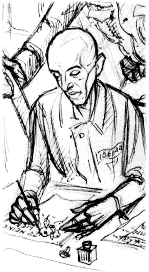David Olère is well-known as an artist whose work testifies to the enormity of the Holocaust. A survivor of Auschwitz, his drawings, paintings, and sculpture have helped considerably to reveal the truth about the atrocities suffered by Jews and other Nazi victims at this notorious death camp.
 David Olère was born in Warsaw, Poland, on January 19, 1902. At a young age, he was accepted into the Academy of Fine Arts, and remained in Poland until he was sixteen. During his teenage years he exhibited woodcuts at museums and art houses in Danzig and Berlin. He was later hired by the Europäische Film Allianz as a painter, sculptor, and architect. So began his short career as a set designer in the film industry. Olère even worked briefly for Paramount Pictures in Europe, and befriended the company's president. In 1930 Olère was married to Juliette Ventura, and the couple moved to a French suburb. They had a son, Alexandre. Once war was declared in Europe, Olère was drafted into the infantry regiment at Lons-le-Saunier. On February 20, 1943, he was arrested by French police during a round up of Jews at Seine-et-Oise. Olère was detained at Drancy, then deported to Auschwitz.
David Olère was born in Warsaw, Poland, on January 19, 1902. At a young age, he was accepted into the Academy of Fine Arts, and remained in Poland until he was sixteen. During his teenage years he exhibited woodcuts at museums and art houses in Danzig and Berlin. He was later hired by the Europäische Film Allianz as a painter, sculptor, and architect. So began his short career as a set designer in the film industry. Olère even worked briefly for Paramount Pictures in Europe, and befriended the company's president. In 1930 Olère was married to Juliette Ventura, and the couple moved to a French suburb. They had a son, Alexandre. Once war was declared in Europe, Olère was drafted into the infantry regiment at Lons-le-Saunier. On February 20, 1943, he was arrested by French police during a round up of Jews at Seine-et-Oise. Olère was detained at Drancy, then deported to Auschwitz.
From March 2, 1943, to January 19, 1945, David Olère was interned at Auschwitz. There he worked as a Sonderkommando, part of a special labor unit responsible for emptying the remains from the ovens of the crematory and for removing the bodies from the gas chambers. The horrors he witnessed there are incomprehensible to anyone who did not personally experience the Holocaust. He saw the victims of the gas chamber undress in the cloakroom, paralyzed with fear and the knowledge of certain death. He saw the incineration of countless bodies. He saw the so-called medical experiments performed on the weak and the sick and the old. He saw the SS rape and torture young Jewish girls. He saw prisoners suffer terrible cruelties while living under the most deplorable of conditions. And on a regular basis, he saw disease, despair, and death. David Olère was one of the few laborers to penetrate the dark interiors of the crematoria and the gas chambers of Auschwitz and to emerge alive. He took part in the evacuation death march of Auschwitz in January of 1945 and was finally liberated by the Americans at Ebensee in May of that year.
The work of David Olère has exceptional documentary value. No photographs were taken at Auschwitz of what went on in the gas chambers and crematoria. Only the memories of Olère, reproduced as art in his drawings and paintings, give an account of the horrible reality. He was the first to draw the plans and cross-sections of the crematories in order to explain exactly how the Nazis ran their death factory. He did not sketch for pleasure while at Auschwitz; there he was forced to work as an illustrator and to write and decorate letters for the SS. One of his paintings shows Olère painting designs on a lampshade. The works of art he produced after his release were created out of an obligation he felt to those who did not survive. He believed he had to tell the true story of their fate, and he did so in the best way he could, through his art. In his paintings he himself is sometimes present as a ghostly face, floating in the background, a silent, pained witness observing the inhuman scenes that could not ever be erased from his memory.
In 1962, David Olère retired from his work as an artist. In 1985, he died. His widow and son have continued his twofold quest of informing the world of the truth about Auschwitz and honoring the victims by remembering their pain. Olère's paintings and drawings have been exhibited at several museums, but spreading his message presents a challenge. The paintings are frequently graphic and repulsive--the gruesome scenes seem to repel the audience rather than attract it. Yet his work only represents the truth, a goal the best of artists aspire to achieve.
SOURCE: Serge Klarsfeld, David Olère: L'Oeil du Témoin/The Eyes of a Witness. New York: The Beate Klarsfeld Foundation, 1989.
For additional Olère artworks along with commentary by his son, see:
David Olère and Alexandre Oler, Witness: Images of Auschwitz. N. Richard Hills, TX: West Wind Press, 1998.
The Bronx High School Web site offers a few additional Olère works not represented in A Teacher's Guide to the Holocaust.
A Teacher's Guide to the Holocaust![]()
Produced by the Florida Center for Instructional Technology,
College of Education, University of South Florida © 1997-2013.